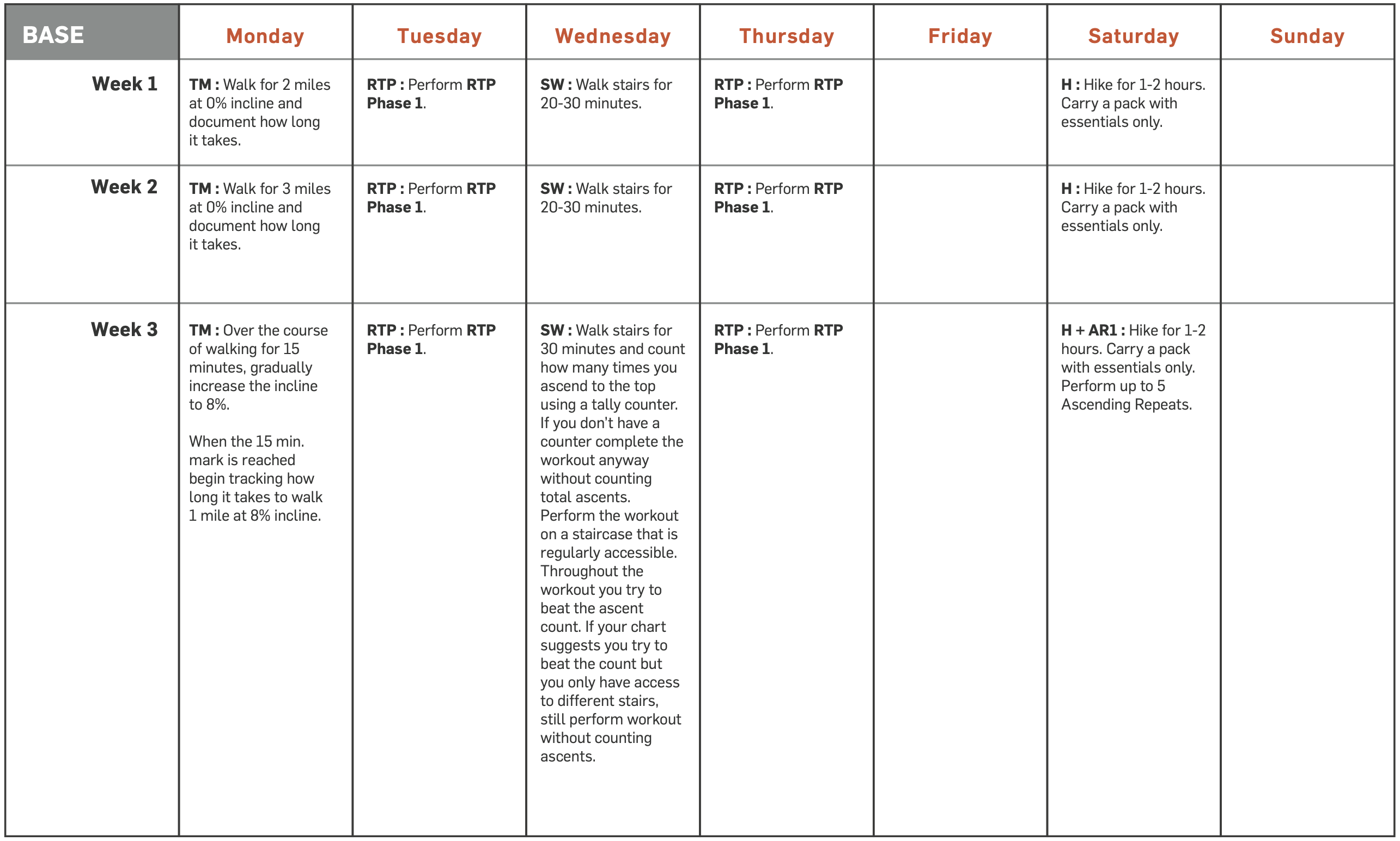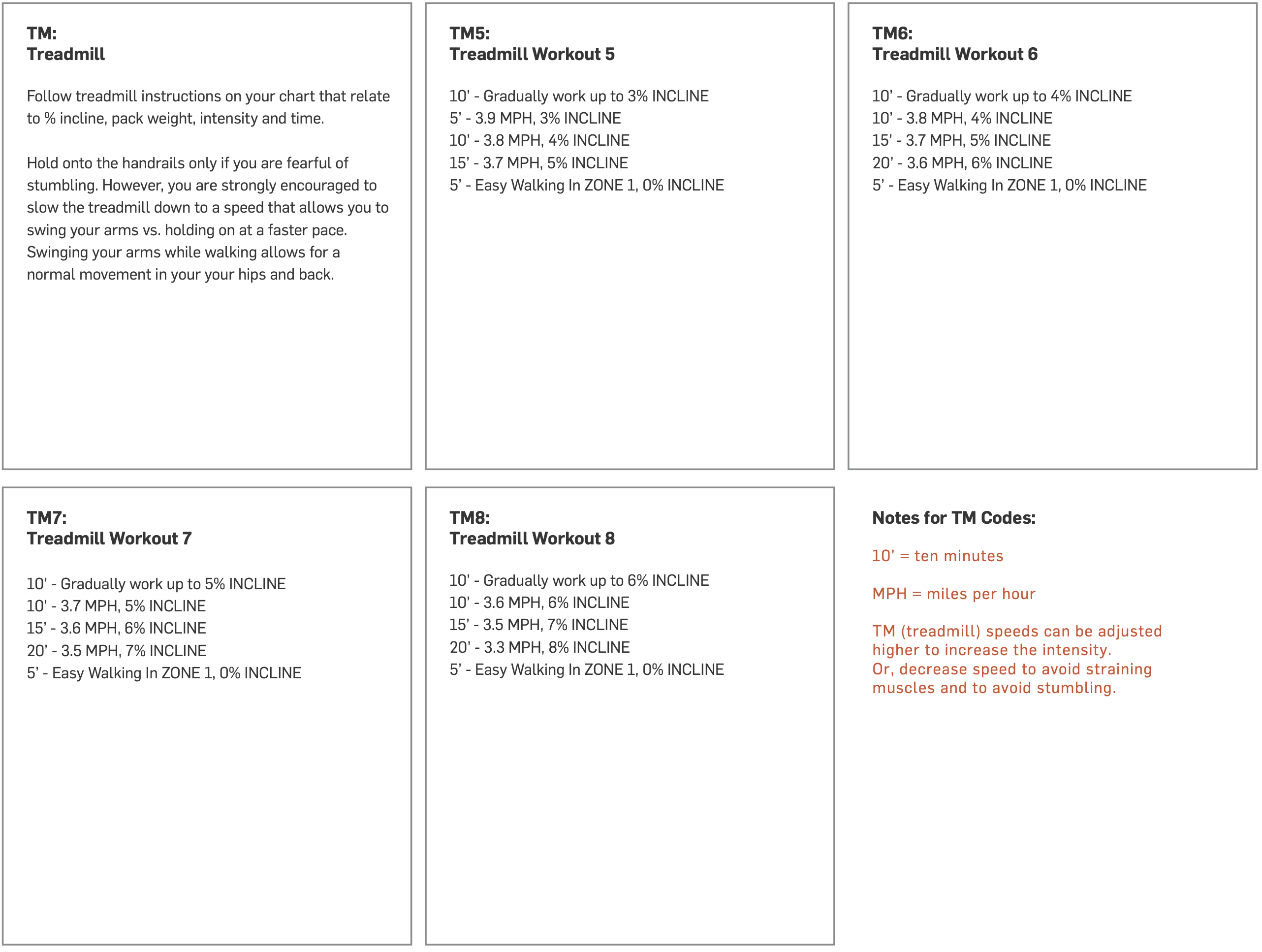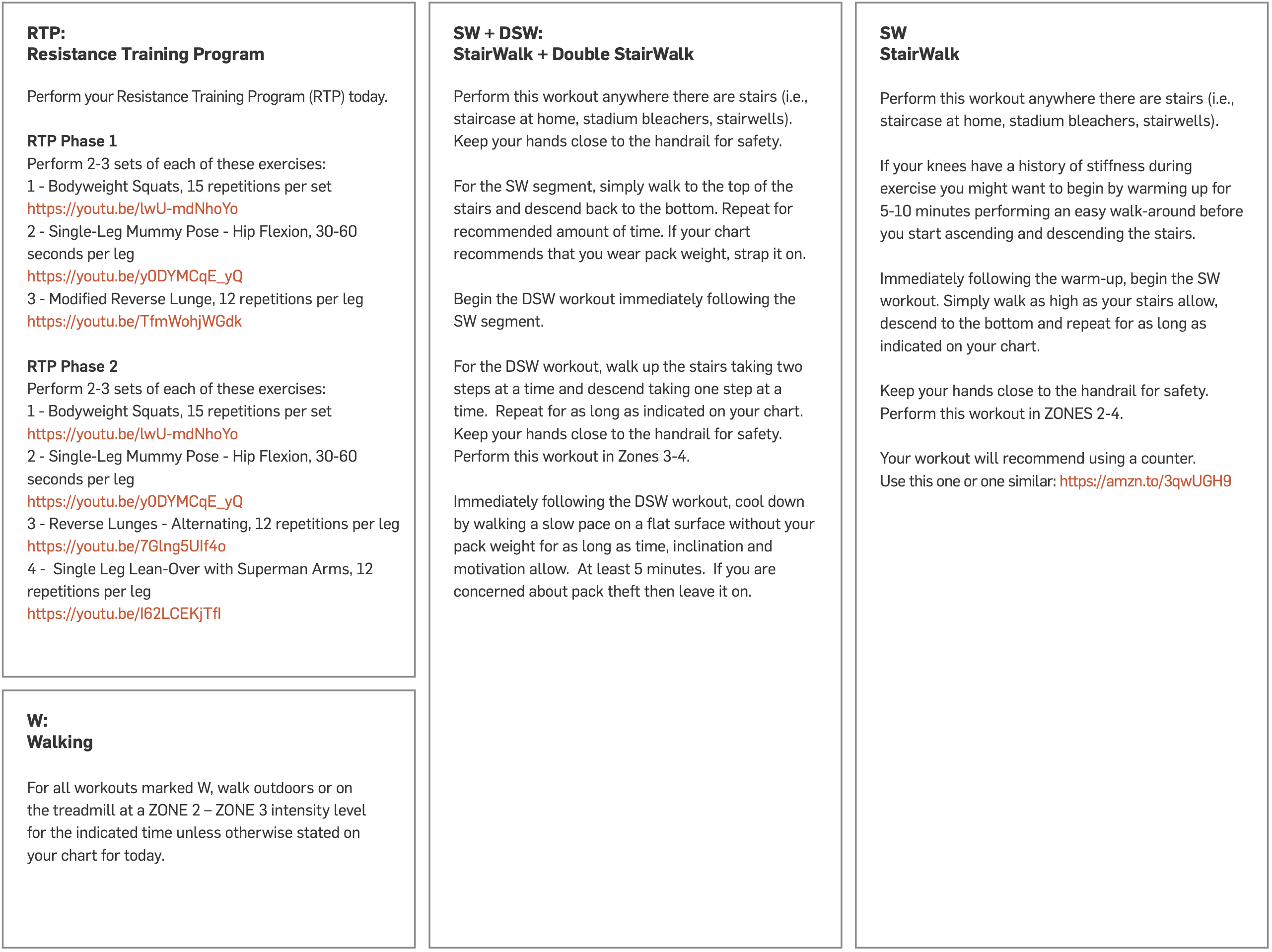Best Hiking Training Plan on the World Wide Web

Benefits of a Hiking Training Plan
Whether you dream of summiting a 14er, 13er, or Mount Kilimanjaro, aspiring to traverse the Grand Canyon from Rim to Rim, are planning your ascent to Everest Base camp, embarking on your first backpacking trip or working up to your first ever hike, following a hiking-specific training program will increase your chances of achieving your hiking goal and will make the experience more enjoyable.
Training plans provide consistency and accountability, taking the guesswork out of preparation, allowing you to trust the process and prepare your body and mind.
While hiking training plans will vary based on your target hike, effective training plans will all incorporate five key pillars.
The Fit For Trips Big 5: Elements of an Effective Hiking Training Plan
- Walk Inclines
- Walk Stairs
- Walk Far
- Walk Lunges
- HIIT Training
1 – Walk Inclines
Walking on inclines (rather than flat terrain) is important for lengthening and strengthening your Achilles, calf muscles, and plantar fascia. Your feet and ankles are the first areas to feel and react to the uneven terrain of hiking trails. Weak, tight feet and ankles will impact all joints above, including knees, hips and back, exposing you to acute and overuse injuries. Look for hilly terrain or any trails that provide ascents. If not available, walk inclines on a treadmill.
2 – Walk Stairs (Up and Down)
Walking stairs is the most effective way to train for hikes as it increases leg power, strength, and endurance. Going down stairs is critical for developing the ability to descend at a controlled pace, enhancing surefootedness and confidence and mitigating fall risk. With a few exceptions, every hiking training program should include stairs. Despite its efficacy, stair training should not be done in isolation, as stairs are flat and do not offer the calf-lengthening benefits of walking inclines.
3 – Walk Far
Every hiking training plan includes walking long distances. The distance you need to walk varies based on your planned trip and current fitness level. An effective training plan will gradually increase the distance you walk to allow you to work up to your goal distance.
4 – Walk Lunges (Strength Training)
All hiking training plans need to incorporate some lower-body strength training. Walking lunges, squats, or step-ups build your large muscles and increase your power through higher load and fewer repetitions (think three sets of 15 repetitions per leg, rather than thousands of steps). Walk Lunges and Walk Far are on two ends of a spectrum yet both are very important.
5 – HIIT Training
High-Intensity Interval Training (HIIT) involves alternating between intense work efforts and rest periods, repeated several times per set. [MS3HIIT training can be done on cardio equipment like an air bike or elliptical machine or through other cardio activities like swimming, swimming, running, jumping rope, etc. A small percentage of your training program should be allotted to HIIT training to improve your physical capacity and endurance.
Hiking Training Plan FAQs
How do you prepare for distance in a training plan for hiking?
To increase your mileage, start by establishing a baseline. Regardless of whether you already walk or run several miles daily or find it challenging to walk a single mile, begin where you are. For outdoor walks or hikes, tracking your miles with your phone or smartwatch can be helpful. A treadmill is a great option for racking up miles if outdoor spaces are unavailable or the weather is unsafe. Whether you walk flat or at a 15% incline, your distance counts, so put on a podcast or your favorite tunes, and go! You can get your miles in with or without getting some elevation gain. But, you need to accumulate elevation gain weekly to complete most bucket list hikes.
How do you prepare for elevation gain in a hiking training plan?
If you live in a hilly or mountainous area with safe outdoor access, you can achieve much of your prescribed elevation gain through hiking. If you have access to hills you can perform repeats walking up to the top and down to the base repeatedly. Do you live in a concrete jungle? Use your office building stairs to train your elevation gain. If you live in a flat area, you can train on the treadmill by increasing the incline or using the stair stepper machine to gain virtual elevation (each floor = 10 feet). Use the calculator linked below to get your numbers.
– To calculate elevation gain on a treadmill, use this calculator
– To calculate elevation gain on stairs, use this calculator
Check out YOUR Hiking Training Plan Below
If you are ready to apply what you learned above, check out your free LEVEL 1 Hiking Training Plan below.
LEVEL 1:
Hiking: Up to 6 miles per day on gentle to moderate gradient trails
Altitudes: Below 6,000 feet
If you want to access LEVEL 2 and LEVEL 3 hiking training plans detailed below, then click here.
LEVEL 2:
Hiking: Up to 10 miles per day on well-formed backcountry trails with some significant gradient inclines and declines
Altitudes: Up to 10,000 feet
LEVEL 3:
Hiking: Up to 14 miles per day and 4,000 feet of elevation gains and losses that cover steep, and rugged terrain
Altitudes: Exceeding 10,000 feet
Hiking Training Plan Level 1 Instructions
- The Level 1 training plan is ideal for newer hikers looking to improve their fitness. Experienced hikers with a consistent training regimen should start with a Level 2 training program.
- A consistent training program can help you conquer any hiking trail on your bucket list, regardless of difficulty level, within a year of starting. Follow this hiking program to help you arrive at the trailhead feeling energized, confident, and strong.
- Your hiking training program is designed to be both comprehensive and user-friendly. You can quickly learn and follow the exercises daily. To make it even more convenient, I have included a code chart below the calendar schedule for quick and easy reference. You can add additional activities and exercises to this program; just be sure that the training volume allows you to recover from week to week. Avoiding acute or chronic injuries is most important.
- Note regarding pack weight for hikes: If you know the weight of the pack you will carry on your hike, then you should train with at least that amount. I have provided pack weight recommendations for those who intend on carrying essentials only, such as water, snacks, a first aid kit, and a layer or two. The training involves overcompensating with extra pack weight to build a strength reserve. If a physician has cleared you to train — but you have joint issues in your lower extremities — then you might omit training with a pack that is more than you will carry on your trip.
- Consult your physician or other healthcare professional before starting this program to ensure it is appropriate for you. You should immediately stop and seek medical attention if you experience faintness, dizziness, pain, or shortness of breath.
Join the Fit For Trips Community
Join the private Hiking Training Solutions Facebook group to post training-program questions, join discussions, and share your goals and experience with me (Marcus) and other like-minded FitForTrippers. Hiking Training Solutions Facebook group is standing by if you need assistance.
How hard should you work in your hiking training plan?

LEVEL 1 Hiking Training Plan
Hiking: Up to 6 miles per day on gentle to moderate gradient trails
Altitudes: Below 6,000 feet
Hiking Training Plan Weeks 1-3

Hiking Training Plan Weeks 4-7

Hiking Training Plan Weeks 8-12

Hiking Training Plan Codes


Resistance Training Program (RTP) Phase 1 Exercises
Perform 2-3 sets of each of these exercises:
1 – Bodyweight Squats, 15 repetitions per set
2 – Single-Leg Mummy Pose – Hip Flexion, 30-60 seconds per leg
3 – Modified Reverse Lunge, 12 repetitions per leg
Resistance Training Program (RTP) Phase 2 Exercises
Perform 2-3 sets of each of these exercises:
1 – Bodyweight Squats, 15 repetitions per set
2 – Single-Leg Mummy Pose – Hip Flexion, 30-60 seconds per leg
3 – Reverse Lunges – Alternating, 12 repetitions per leg
4 – Single Leg Lean-Over with Superman Arms, 12 repetitions per leg

Your Hiking Training Program Follows These Important Elements
Following a hiking training plan effectively involves a combination of structured planning, consistency, and adaptability. Here’s a guide on how to best follow a hiking training plan:
Set Clear Goals:
Define your hiking goals, whether it’s conquering a specific trail, completing a certain distance, or achieving a target elevation gain. Having clear objectives will help tailor your training plan to your needs. You have access to all 3 Levels of the Hiking Training Program to match your goals.
Gradual Progression:
Start gradually and progress steadily. Avoid pushing yourself too hard initially, as this can lead to burnout or injury. Increase your hikes’ intensity, duration, and elevation gain progressively over time. Your training plan starts gradually and incorporates recovery weeks. If necessary, reduce each day’s distance or time by half to start with.
Consistency is Key:
Stick to a consistent training schedule. Regularity is more important than occasional intense workouts. This will help your body adapt to the demands of hiking.
Adapt to Terrain and Altitude:
If your hiking goal involves specific terrains or altitudes, incorporate training elements that mimic those conditions. This could include hill workouts, altitude training, or practicing with a loaded backpack. The hiking training plan combines all five of the Fit For Trips Big 5, compensating for a lack of aggressive or unavailable hiking trails.
Listen to Your Body:
Pay attention to your body’s signals. If you experience pain, fatigue, or signs of overtraining, consider adjusting your plan or taking extra rest days. Recovery is crucial for long-term success.
Include Rest Days:
Schedule regular rest days to allow your body to recover. Rest is essential for preventing injuries and ensuring your muscles have time to repair and strengthen.
Stay Hydrated and Nourished:
Proper nutrition and hydration are integral parts of any training plan. Ensure you’re fueling your body with the right nutrients and staying adequately hydrated, especially during longer or more intense workouts.
Document Your Progress:
Keep a training journal to track your progress. Note the distance, elevation gain, and any challenges you faced during each workout. This can help you identify patterns, adjust your plan as needed, and celebrate your achievements. Print out the program to make notes on.
Stay Flexible:
Be flexible and willing to adjust your plan based on your evolving fitness level, schedule, or unexpected circumstances. Life happens, and being adaptable will help you stay on track in the long run.
Seek Professional Guidance:
This hiking training plan is for someone who prefers to work independently. If you think you will succeed better with the help of a coach, need accountability, or need customization, contact Marcus Shapiro – head strength and conditioning coach of Fit For Trips.

Bob Bennett
My goal is rim to rim, how much do you charge for a training plan
Marcus Shapiro
Hi Bob. Thanks for asking. A successful Rim to Rim hike is a life changing experience. Here is the 12 week rate structure. However, I often work with clients for 4 weeks to set them on a trajectory to be successful working out independently. Let me know if you would like to discuss your current training plans and see if coaching is a good solution for you.